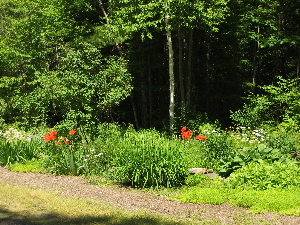CUTTING THE GRASS AND OTHER FALL PLEASURES
Yesterday, my husband cut the grass for the last time. You have to remember we live in the country where grass is not manicured and admired. It's something that covers the soil, often harboring weeds we don't trouble with at all.
When he cuts the grass, he uses a big Dr. Mower. It covers a lot of ground; cuts down substantial growth around the edges of the yard; and handles the hills a bit easier than a lawn mower would. Then when he's finished with that, he gets out the bushwhacker and goes after the places the Dr. Mower can't reach easily. He probably does this chore about 3 or 4 times during the course of the growing season. It's enough.
When he's done, it's my turn to rake and get it into the compost bin. Putting grass in the compost bin is a bit of a chore because it needs to be mixed once it's in there. If you don't mix this green stuff into the compost it will pack down and also begin to smell. You definitely don't want a smelly compost bin!
When I lived in Connecticut where we had a beautiful lawn, I would use the lawn mower to cut the grass in long strips where I could collect it in a big tarp. It had autumn leaves mixed in with it so the leaves and grass were chopped up together. That meant I did not have to mix it once it was in the compost bin. What a wonderful mix that was. In the spring, it was ready to be applied to the garden. I wish I could do that here!
I'm about at the point where I stop adding to the bin until spring. In my younger years, I added stuff all winter long. Now I just cannot handle climbing over snow banks!
Something else I have been adding to the compost bin is the paper from my paper shredder! The less I have to add to the land fill the better.










